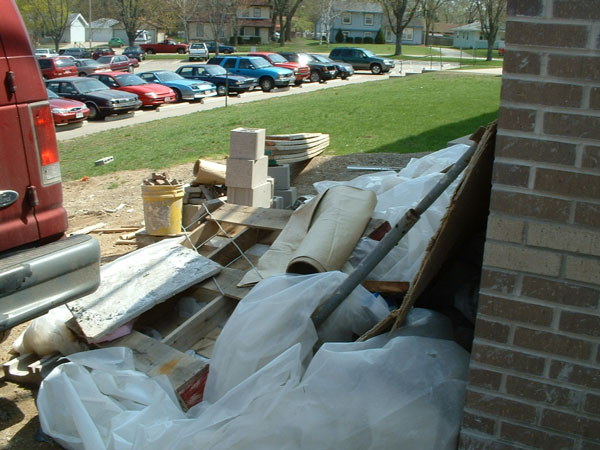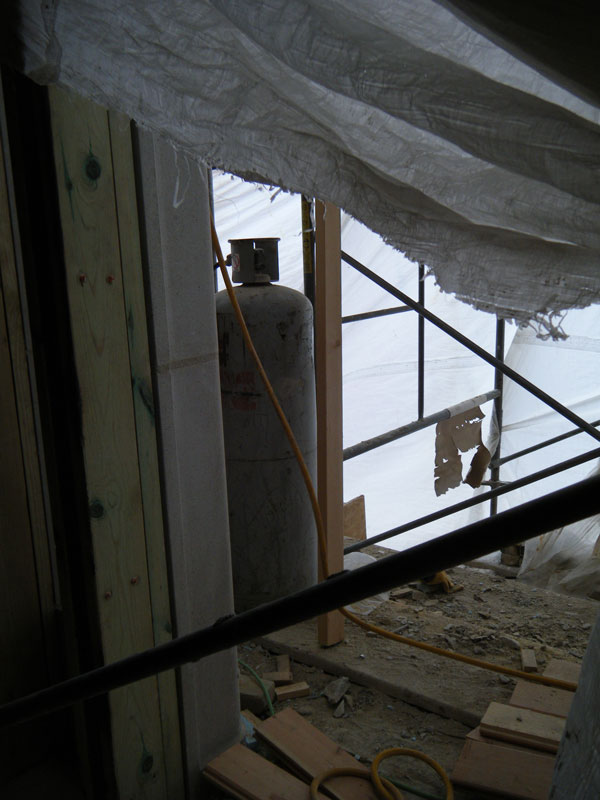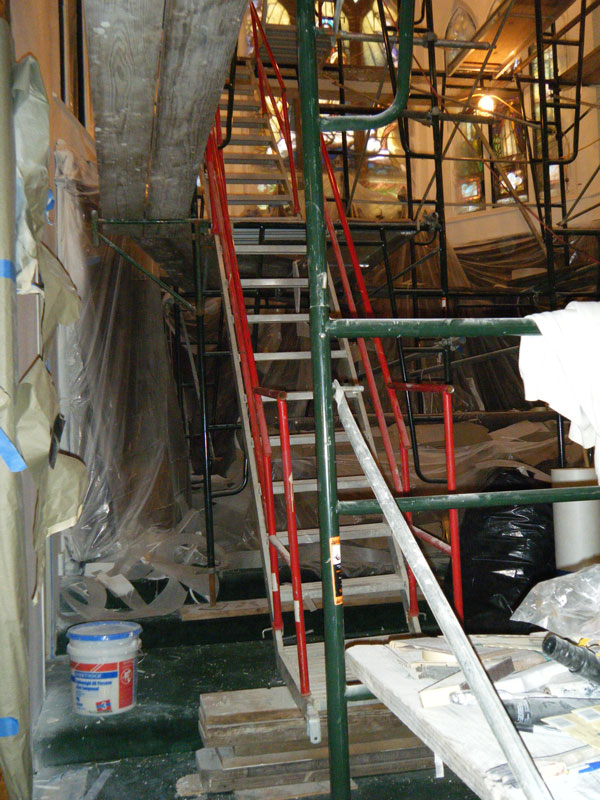
By Greg Havel
Construction job sites are not exempt from serious fires. On May 19, 2000, a crane setting wood roof trusses on a three-story wood-frame apartment building in Tampa, Florida, made contact with overhead electric wires, energizing the machine and igniting dry grass, trees, and construction debris next to one of the buildings. The fire quickly spread to the buildings in the complex, all of which were under construction with no fire stops, drywall, or fire sprinklers in place yet. The fire was controlled after more than eight hours work by more than 150 firefighters from two counties, using water flows that exceeded 10,000 gallons per minute. No construction workers were injured, but four firefighters were hospitalized and several others injured. The 750-unit apartment complex under construction covered four city blocks and was destroyed. Six buildings downwind and across the street were destroyed or damaged. The value of property damage and lawsuits was nearly $100 million. Search the Internet for “Ybor City Fire” for photos, videos, and media accounts.
RELATED: YBOR CITY FIRE, Tampa, Florida
There are some simple things we can do to prevent fires and related injuries on construction job sites. We can ensure that:
- Contractors clean up rubbish and debris as it is generated and put it in dumpsters, away from the building. (Photo 1)
- Flammable liquids (gasoline and diesel fuel) and LP gas are stored outside the building, away from ignition sources, and outside of heated enclosures or trailers.
- LP gas tanks or cylinders used to supply temporary heaters are located outside the heated space and outside the building, and restrained upright so that they cannot tip over. Photo 2 shows an unrestrained 100-pound (45 kg) propane (LP) cylinder located on a scaffold platform inside a heated winter enclosure that is an extension of an upper floor of a wood-frame building.
- Fire extinguishers are available throughout the work area. Some contractors prefer to keep these in their trailers, in their trucks, and in their gang boxes located in work areas (they tend to disappear if left unattended).
- At least two exits from the building are available to workers for emergency evacuation. These must be unlocked at the beginning of the work day, but may be secured at the end of the day. If the building is large enough to require more than two exits when completed, it is large enough that all exits should be available to construction workers in an emergency. There must also be at least two means of evacuation from upper floors to ground level. Photo 3 shows a ladder that is in place for access to and evacuation from an industrial mezzanine, which was in use until the permanent steel stairway and guardrail system were installed. Photo 4 shows a scaffold stair tower that was part of the four-story scaffold system inside a church during renovation.
- A clear area at least five feet in diameter is maintained around small temporary heaters; and more for larger ones; as recommended by the heater manufacturer.
- All rubbish and combustibles within 15 feet of any “hot work” (welding, torch cutting, grinding, or soldering) at floor levels (and within 35 feet if the work is overhead or near a high ceiling) have been removed or shielded with noncombustible screens or tarps; that hot work permit requirements are followed; and that the project manager is notified before hot work begins.

(1)

(2)

(3)

(4)
These are the same recommendations and code requirements that we enforce in schools, apartment buildings, mercantile, and factory buildings. Although construction job sites are sometimes held to a lesser standard than completed, occupied buildings, the higher standard will produce a more pleasant and more fire-safe work environment.
Many construction job sites involve additions to or remodeling of existing buildings. Some of these buildings, including schools, medical facilities, and other public facilities, are required to have fire alarms systems. These systems must be tested periodically, and fire drills conducted for the building’s occupants. These requirements are contained in Occupational Safety and Health Administration’s (OSHA) regulations and in state statutes, administrative codes, and local ordinances. They apply to construction workers on site as well as to employees and other occupants of the buildings.
The OSHA regulations also require construction workers to have an evacuation plan for the job site in case of a fire or other emergency. Complacency often suggests to the contractors that they will not have an incident and so will not need one of these plans. Sometimes the evacuation plan is prepared by the building’s owner, especially when the job site is small and within a larger building, with obvious or well-marked exit routes and posted evacuation plans. Contractors should be encouraged to prepare both evacuation and disaster plans for their job sites, to train their employees in the procedures, and to review these plans with their employees periodically.
Contractors and their employers must be encouraged to respond to the sounding of fire alarms and other emergency notifications when they are working in buildings where these are functioning. As everyone has been taught since elementary school, contractor employees must assume that there is a fire or other emergency when fire alarms or other emergency notifications are heard. It is as essential for contractor employees to evacuate the building as it is for the building’s regular occupants, for their own safety. There are only two exceptions to this statement:
- The first is when a fire alarm test is being conducted by a contractor or inspector, and the contractors have been notified in advance that it is only a test.
- The second is when a contractor has been notified by the building manager that there will be a fire drill, and that work is to continue through it so that a critical phase of work will not be interrupted. (A critical phase of work might be a half-day continuous pour of concrete, which, if interrupted, could cause structural weakness in the finished building; a utility shut-down in an occupied building; or work in a health-care facility that must be completed by a deadline because of scheduled surgery or other medical procedures. It is not a contractor’s preference because of being behind schedule.) In this case, the building manager should review the emergency and job site emergency and evacuation procedures with the workers who do not participate in the drill.
If a construction job site must be evacuated, the office or tool trailer can be designated as the assembly area for each contractor’s employees, so that their supervisors can more easily account for them. Other assembly areas can work as well, provided that they are designated in advance and will not obstruct emergency response vehicles and operations.
The few minutes that it may take to ensure that contractor employees participate in evacuation drills in occupied facilities, or that it may take us to assist them in developing and exercising evacuation and disaster plans, can be inexpensive and valuable experience for both the contractors and emergency responders, if there is ever a need for such an evacuation.
Download this article as a PDF HERE.
 Gregory Havel is a member of the Town of Burlington (WI) Fire Department; retired deputy chief and training officer; and a 35-year veteran of the fire service. He is a Wisconsin-certified fire instructor II, fire officer II, and fire inspector; an adjunct instructor in fire service programs at Gateway Technical College; and safety director for Scherrer Construction Co., Inc. Havel has a bachelor’s degree from St. Norbert College; has more than 35 years of experience in facilities management and building construction; and has presented classes at FDIC.
Gregory Havel is a member of the Town of Burlington (WI) Fire Department; retired deputy chief and training officer; and a 35-year veteran of the fire service. He is a Wisconsin-certified fire instructor II, fire officer II, and fire inspector; an adjunct instructor in fire service programs at Gateway Technical College; and safety director for Scherrer Construction Co., Inc. Havel has a bachelor’s degree from St. Norbert College; has more than 35 years of experience in facilities management and building construction; and has presented classes at FDIC.
MORE CONSTRUCTION CONCERNS

